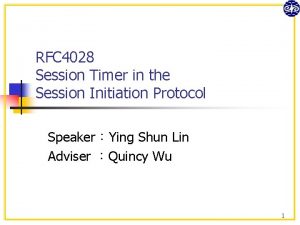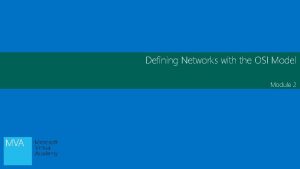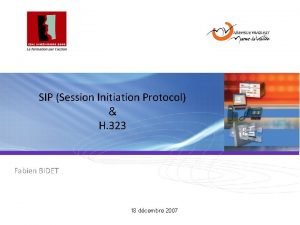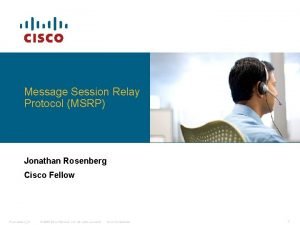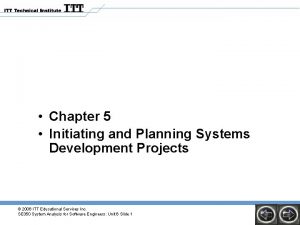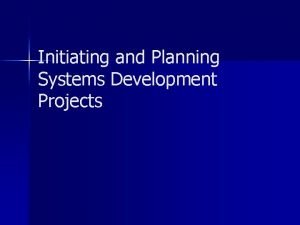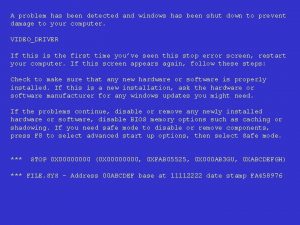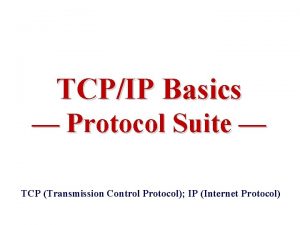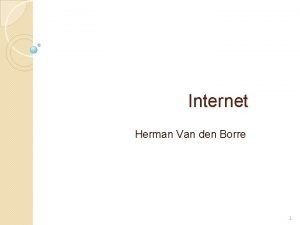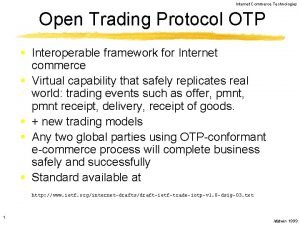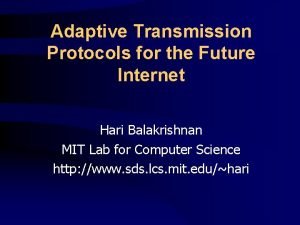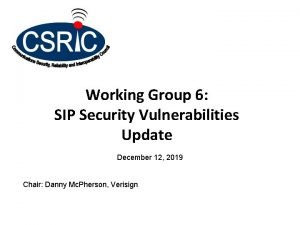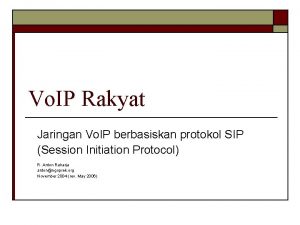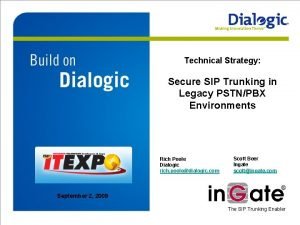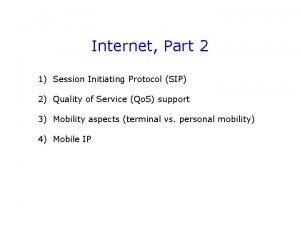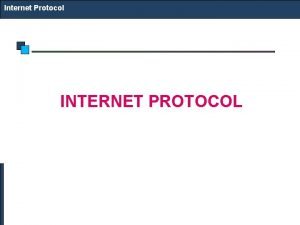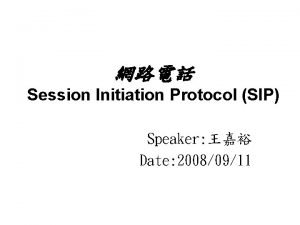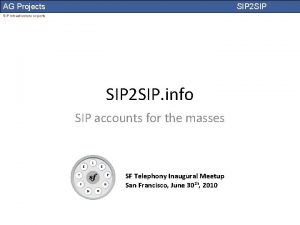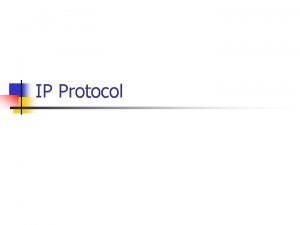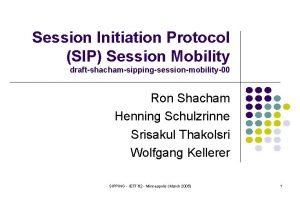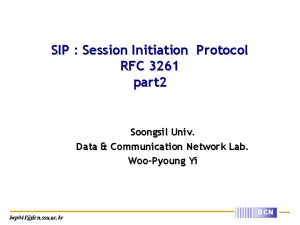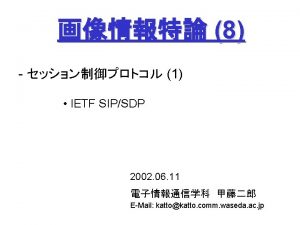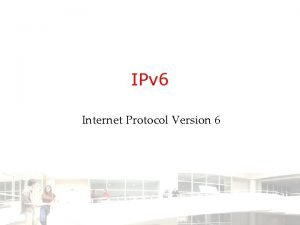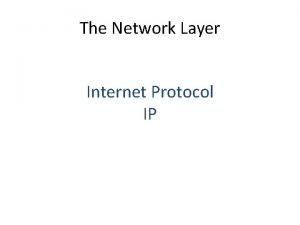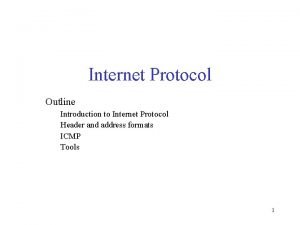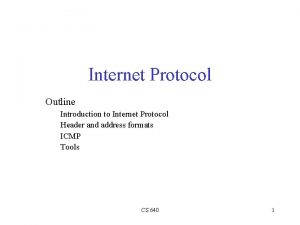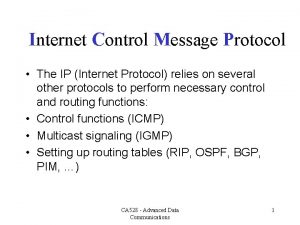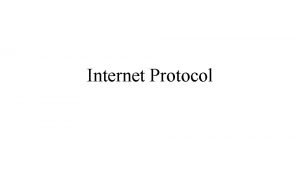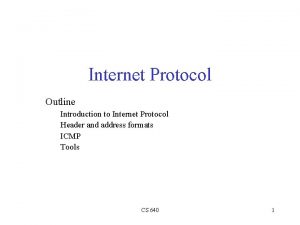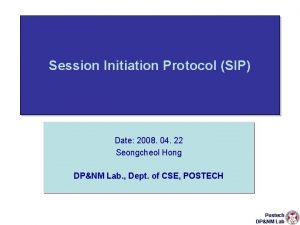Internet Part 2 1 Session Initiating Protocol SIP






































- Slides: 38

Internet, Part 2 1) Session Initiating Protocol (SIP) 2) Quality of Service (Qo. S) support 3) Mobility aspects (terminal vs. personal mobility) 4) Mobile IP

Session Initiation Protocol (SIP) SIP is a protocol for handling multiparty multimedia calls (sessions). The IP routes of the control plane (SIP signalling) and user plane (multimedia data) are separate. SIP signalling User B User A Multimedia data http: //www. ietf. org/rfc 3261. txt User C

SIP vs. H. 323 is a suite of protocols for managing multiparty multimedia calls in the PSTN (in other words using circuit switched technology). Contrary to SIP, H. 323 is used today (among others it forms the basis for Microsoft’s Net. Meeting application). H. 323 is more complex than SIP (this is the reason we will not go into more detail in this course). SIP has been chosen for handling call control in the IMS (IP Multimedia Subsystem) specified in 3 GPP Release 5. H. 323 standards (ITU-T) vs. RFC 3261 (good tutorial)

SIP offers the following features Signalling for handling of multiparty calls Call forking (several users are alerted at the same time) Capability of multimedia calls (voice , video, etc. at the same time) can be negotiated using Session Description Protocol (SDP) messages carried over SIP User-friendly addressing (sip: alice@net 1. com) Personal mobility (but not terminal mobility) Good flexibility, scalability, extensibility Interworking between SIP telephony and PSTN telephony (as well as between SIP addressing and E. 164 addressing).

Basic (two-party) SIP call (1) SIP proxy of user A Request Response Invite. . . User A net 1. com SIP address of Alice: sip: alice@net 1. com alice. cooper@net 1. com User B bob. jones@place 2. com “Invite” message (corresponding to IAM message in ISUP) is sent to SIP proxy of user A. The message includes SIP address (sip: bob@net 2. com) of user B.

Basic (two-party) SIP call (2) SIP proxy of user A SIP proxy of user B Invite. . . net 1. com User A alice. cooper@net 1. com net 2. com User B bob. jones@place 2. com “Invite” message is routed to SIP proxy of user B (Bob). How does SIP proxy of Bob know where Bob is at this moment? (At home, at work, at computer Z, . . . ? )

SIP registration SIP proxy of user A net 1. com User A alice. cooper@net 1. com SIP proxy of user B net 2. com route Invite message to: bob. jones@place 2. com 2 1 Register. . . User B bob. jones@place 2. com The answer is: the terminal of Bob has performed SIP registration. “Register” messages including the URL of Bob’s current terminal are sent initially (and at regular intervals) to the SIP proxy.

Basic (two-party) SIP call (3) SIP proxy of user A net 1. com User A alice. cooper@net 1. com SIP proxy of user B net 2. com Invite. . . User B bob. jones@place 2. com “Invite” message is routed to Bob’s terminal using Bob’s URL provided via SIP registration. Alice’s URL (alice. cooper@net 1. com) is included in the message.

Basic (two-party) SIP call (4) SIP proxy of user A SIP proxy of user B 180 Ringing net 1. com User A alice. cooper@net 1. com net 2. com User B bob. jones@place 2. com Bob’s terminal is ringing. An (optional) “ 180 Ringing” message is routed back to user A (Alice) and an audio ringing tone is generated in Alice’s terminal.

Basic (two-party) SIP call (5) SIP proxy of user A SIP proxy of user B 200 OK net 1. com User A alice. cooper@net 1. com Ack net 2. com User B bob. jones@place 2. com Bob answers the call. A “ 200 OK” message is routed back to Alice sends an “Ack” message to Bob.

Basic (two-party) SIP call (6) SIP proxy of user A User A alice. cooper@net 1. com SIP proxy of user B User B bob. jones@place 2. com After successful session establishment, the user plane data (e. g. coded speech carried on top of RTP) is carried between the terminals directly through the Internet without involving SIP proxies.

SIP forking example SIP proxy of user A SIP proxy of user B Terminal 1 Invite. . . User A Terminals of user B that have performed SIP registration Terminal 2 Terminal 3 Forking: Different terminals of user B are alerted at the same time. The one that answers first returns the 200 OK message. . .

Three types of addresses E. 164 address 358 9 1234567 MSISDN 050 1234567 Address points directly to called user in the PSTN Address points to HLR in GSM home network of called user HLR knows where to route call SIP address sip: user@network. com Address points to SIP proxy of called user SIP proxy knows where to route “Invite” SIP message

What can SIP do? The most important task of SIP is to find out URLs of terminals to be included in the multimedia session (see previous example). For negotiation of multimedia capabilities, SIP can carry SDP messages between end users (in “Invite” and “ 200 OK” SIP messages). Unfortunately, SIP cannot influence the transport in the user plane (support of Qo. S and security features, inclusion of PCM/EFR transcoding equipment, etc. ).

IP Multimedia Subsystem (IMS) AS (Application Server) AS AS IMS (IP Multimedia Subsystem) CSCF (Call Session Control Function) SGSN User A GGSN SIP Location Database (usually combined with HLR) CSCF GGSN SGSN User B

Why IMS? In a “conventional” GPRS-based IP network, only Client-Server types of applications are possible. Client-Client (or peer-to-peer) types of applications are not possible since the dynamic IP address of the user B terminal is not known in the network. Possible Server Not possible SGSN User A GGSN SGSN User B

IMS operation (1) User B can be reached only after registering in the IMS, which means binding her/his SIP address with the dynamic IP address that was allocated when the PDP context of the GPRS session was established. IMS (IP Multimedia Subsystem) SIP Location Database Register! SGSN User A GGSN SGSN User B

IMS operation (2) Session (or call) control involves SIP signalling as well as network functions provided by the IMS (for instance, CSCF offers SIP proxy functionality). IMS (IP Multimedia Subsystem) CSCF SIP Location Database Invite 200 OK SGSN User A GGSN SGSN User B

IMS operation (3) Also, external application servers (e. g. presence server) can be employed during session control. AS IMS (IP Multimedia Subsystem) CSCF SGSN User A GGSN CSCF GGSN SIP Location Database SGSN User B

IMS operation (4) After successful session establishment, the IMS is not involved in the transfer of user data (e. g. , encoded speech) between the user A and B terminals. IMS (IP Multimedia Subsystem) CSCF SIP Location Database User data over RTP SGSN User A GGSN SGSN User B

Qo. S support in IP networks “Best effort” service <=> no Quality of Service support Some alternatives for introducing Qo. S in IP backbone applications (situation year 2004): Alternative 1: RSVP (Resource Re. Ser. Vation Protocol) Alternative 2: Diff. Serv (Differentiated Services) Alternative 3: MPLS (Multi. Protocol Label Switching) Alternative 4: IP tunneling over ATM IETF terminology: Traffic engineering

Problems with “Best effort” IP transport "Best effort" service is sufficient for traditional Internet applications like web browsing, e-mail, and file transfer. "Best effort" is not sufficient for real-time applications: Speech (voice) Video / audio streaming Multimedia applications Low delay High throughput Low delay variation Consistent throughput Low round-trip delay

Qo. S support mechanisms (1) RSVP (Resource Re. Ser. Vation Protocol) IETF RFC 2205 Resources are reserved beforehand (or at certain intervals) Host Egress point Ingress point IP Backbone http: //www. ietf. org/rfc 2205. txt RSVP can be considered an example of the integrated services concept (compare with differentiated services). RSVP is typically used together with other mechanism(s).

Qo. S support mechanisms (2) Diff. Serv (Differentiated Services) IETF RFC 2475 Service ”tagging” in To. S byte at ingress point Host Egress point Ingress point IP Backbone Traffic control based on To. S byte IPv 4 Header Version IHL Type of Service Identification Time-to-live Protocol http: //www. ietf. org/rfc 2475. txt Total length Flags Header To. S byte = 8 bits (28 = 256 priority levels could be used)

Qo. S support mechanisms (3) MPLS (Multi-Protocol Label Switching) IETF RFC 2702 Label switching in all routers along the path Host Egress point Ingress point IP Backbone LSR = Label Switch Router (router with MPLS functionality) http: //www. ietf. org/rfc 2702. txt Virtual connection must be established first (using e. g. RSVP). IP datagrams are encapsulated in MPLS frames and relayed through label switch routers (only label is used for routing).

Qo. S support mechanisms (3 cont. ) MPLS label structure: IP datagram Header of layer 2 protocol data unit L 2 payload L 2 H L 2 payload Label routing without MPLS L 2 H in case of MPLS Label length = 32 bits TTL (8 bits) Stacking: L 2 Payload S Exp Label value (20 bits) Stack bit identifies bottom-of-stack label Label L 2 H Label at top of stack is always in use first

Qo. S support mechanisms (3 cont. ) Routing without MPLS: destination IP address in IP header is used for routing. L 2 payload DA L 2 H In case of MPLS: destination IP address is not used for routing along the virtual path between ingress and egress point. Routing is based on MPLS label instead. L 2 payload DA Label L 2 H

Qo. S support mechanisms (4) IP tunneling over ATM IP packets are directed to the ingress point IP traffic is carried over ATM virtual connection Host Egress point Ingress point ATM Backbone See lecture slides on ATM for protocol stacks involved

Problem with end-to-end Qo. S support There are millions of Internet routers worldwide based on IPv 4 and without any Qo. S support. Efficient Qo. S support worldwide means that a large part of these routers must be updated. Conventional routers Terminal Edge router Terminal Routers offering Qo. S support Edge router

Situation is “easier” in this case Traditional circuit switched network: Terminal Switch Terminal No store-and-forward nodes in network => predictable delay Circuit switched network including IP bearer section: Terminal Switch Edge router Switch IP backbone Terminal Edge router Qo. S support: Small/predictable delay between edge routers

Mobility in IP networks One can very generally define two types of mobility: Personal mobility (e. g. offered by SIP) Terminal mobility (e. g. offered by GPRS) The concept “Mobile IP” tries to combine both, when implemented together with wireless LAN technology (see last slides of this lecture). The IMS (IP Multimedia Subsystem) concept in 3 GPP Release 5 also tries to combine both (using SIP and GPRS technology).

User mobility vs. terminal mobility Personal mobility (e. g. offered by SIP): User can move around in the network and use a new terminal after registration via the new terminal. The new terminal has the same address for incoming calls as the old terminal. However, terminal mobility is not supported. Terminal mobility (e. g. offered by GPRS): User can move around in the network and use the terminal at different locations => location updating. However, using different terminals means different addresses as far as incoming calls are concerned.

Mobile IP concept - IETF solution for (e. g. ) Wireless LAN –type applications - Wide-scale deployment together with IPv 6 ? Basic architecture: Mobile Node Care-of address IP address 3 http: //www. ietf. org/rfc 2002. txt Foreign Agent Correspondent Node IP address 1 Home Agent Home address IP address 2

Mobile IP (cont. ) Mobile node -terminated IP transport: Mobile Node Care-of address (IP address 3) Foreign Agent Correspondent Node 2 Home Agent 1 Home address (IP address 2) (IP address 1) 1. Correspondent node sends IP packet to permanent home address (corresponding URL is known). 2. Home agent tunnels IP datagram to care-of address.

Mobile IP (cont. ) Tunneling in Mobile IP means encapsulation: Mobile Node Foreign Agent Home Agent Care-of address (IP address 3) Home address (IP address 2) Original IP datagram IP header IP payload IP datagram sent to mobile node

Mobile IP (cont. ) Mobile node -originated IP transport: Mobile Node Care-of address (IP address 3) Note: source address in IP datagram is home address (IP address 2), not care-of address (IP address 3) Foreign Agent Correspondent Node Home Agent Home address (IP address 2) (IP address 1) Mobile node sends IP packets directly to correspondent node (no tunneling required).

Mobile IP (cont. ) Mobility requires: (1) agent advertisements Mobile Node Care-of address (IP address 3) Foreign Agent Home address (IP address 2) 1. “New” mobile node has no valid care-of address. 2. Foreign agents continuously broadcast (at 1 s intervals) lists of free care-of addresses within their area. 3. Mobile node selects a care-of address and informs the foreign agent.

Mobile IP (cont. ) Mobility requires: (2) registration Mobile Node Care-of address (IP address 3) Foreign Agent Home address (IP address 2) 1. Mobile node informs home agent about new care-of address. 2. Home agent replies with ”OK”-message (or resolves the problem if situation is not OK). 3. From now on home agent can tunnel IP packets to mobile node (using care-of address).
 Rfc4028
Rfc4028 Qu es
Qu es Sip protocol structure
Sip protocol structure Session protocol data unit
Session protocol data unit Fabien bidet
Fabien bidet Relay protocol
Relay protocol Marketing essentials chapter 13
Marketing essentials chapter 13 Bcf model conflict resolution
Bcf model conflict resolution Initiating and planning systems development projects
Initiating and planning systems development projects User requirement
User requirement How many stages does coming together process have?
How many stages does coming together process have? Attending responding personalizing initiating
Attending responding personalizing initiating Initiating and planning systems development projects
Initiating and planning systems development projects Leadership challenges for the youth of today
Leadership challenges for the youth of today Initiating process group
Initiating process group A problem has been detected and omegaos has been shut down
A problem has been detected and omegaos has been shut down Problem has been detected and windows needs to shut down
Problem has been detected and windows needs to shut down Security architecture for the internet protocol
Security architecture for the internet protocol Internet transport protocol in computer networks
Internet transport protocol in computer networks Dongyang mirae university
Dongyang mirae university Internet official protocol standards
Internet official protocol standards Internet protocol cursus
Internet protocol cursus Internet open trading protocol
Internet open trading protocol Schemat logiczny sieci komputerowej
Schemat logiczny sieci komputerowej Iptv internet protocol television
Iptv internet protocol television Adaptive internet protocol
Adaptive internet protocol What is internet
What is internet Addition symbol
Addition symbol Part to part ratio definition
Part to part ratio definition Brainpop ratios
Brainpop ratios What is a technical description?
What is a technical description? What are the parts of the bar
What are the parts of the bar The phase of the moon you see depends on ______.
The phase of the moon you see depends on ______. Two way anova minitab 17
Two way anova minitab 17 Sip security vulnerabilities
Sip security vulnerabilities Berikut format alamat sip yang benar adalah
Berikut format alamat sip yang benar adalah Verizon sip trunk
Verizon sip trunk Sip trunking poole
Sip trunking poole History-info sip header
History-info sip header
